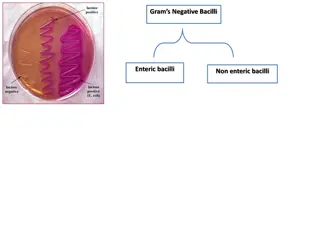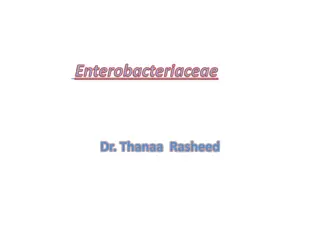Understanding Atrophic Rhinitis: Causes, Symptoms, and Diagnosis
Atrophic rhinitis is a progressive chronic condition characterized by the atrophy of nasal mucosa and turbinates. It predominantly affects young to middle-aged adults, with females being more prone. Commonly isolated bacteria include Klebsiella ozaenae and others. The pathophysiology involves metapl
0 views • 12 slides
Klebsiella Species: Characteristics and Pathogenicity
Klebsiella species, such as K. pneumoniae and K. oxytoca, are gram-negative bacilli commonly found in the microbiota of the intestines, nasopharynx, and feces. They exhibit distinct characteristics like pink mucoid colonies on MacConkey's agar and are known to cause both community-acquired and hospi
0 views • 24 slides
Best Practices for Preventing Infections and Antibiotic Stewardship
Preventing infections involves measures such as wearing masks, practicing hand hygiene, cleaning surfaces, and staying home when ill. Multi-resistant organisms (MRO) like MRSA and Klebsiella pose a threat, particularly in healthcare settings. Proper hand hygiene, including using alcohol-based hand s
1 views • 8 slides
Overview of Gram-Negative Enteric Bacilli
Gram-negative bacilli are a diverse group of bacteria, including enteric and non-enteric bacilli. Common characteristics include being aerobic or facultative anaerobes, fermenting glucose, and being part of the normal flora of the human and animal gastrointestinal tract. Escherichia coli (E. coli) i
0 views • 27 slides
Overview of Enterobacteriaceae Family and Their Antigenic Structure
The Enterobacteriaceae family comprises a diverse group of gram-negative rods commonly found in the gut of humans and animals, known for causing various diseases. Key members include Escherichia coli, Shigella, Salmonella, Klebsiella, and more. They are facultative anaerobes, ferment glucose, lack c
0 views • 48 slides
Managing MDR Gram-negative Enterobacteriaceae Outbreaks in Hospitals: Response Strategies and Best Practices
Hospitals face a growing threat from multidrug-resistant Gram-negative bacteria, such as Acinetobacter baumannii and Klebsiella pneumoniae. This article discusses the emergence of carbapenem-resistant Enterobacteriaceae in Europe and outlines response strategies, including lab screening, communicati
0 views • 23 slides





